Use the Morpher modifier to change the shape of a mesh, patch, or NURBS model. You can also morph shapes (splines), and World Space FFDs. As well as morphing from one shape to another, the Morpher modifier also supports material morphing.

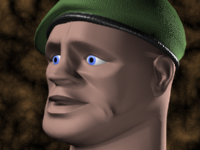
On this patch model, morph targets are created by moving control vertices and tangent handles in an Editable Patch.
Morphing is commonly used for lip sync and facial expression on a 3D character, but can be used to change the shape of any 3D model. The modifier provides 100 channels for morph targets and materials. You can mix channel percentages and use the result of the mix to create a new target.
On a mesh object, vertex count on the base object and targets must be the same. On a patch or NURBS object, the Morpher modifier works on control points only. This means that you can increase the resolution of patches or NURBS surfaces on the base object to enhance detail at render time.
A Flex modifier above the Morpher modifier is aware of vertex or control-point motion in the Morpher modifier. If, for example, a jaw is morphed to slam shut, then you can use a Flex modifier placed above the Morpher modifier in the modifier stack to make the lips quiver, thus simulating soft tissue.
For lip sync and facial animation, create a character's head in an "at rest" pose. The head can be a mesh, patch, or NURBS model. Copy and modify the original head to create the lip-sync and facial-expression targets. Select the original or "at rest" head and apply the Morpher modifier. Assign each lip-sync and facial-expression target to a channel in the Morpher modifier. Load an audio file in the Track View sound track, turn on Auto Key, scrub the time slider, and view the audio waveform in Track View to locate frames for lip sync. Then set the channel spinners on the Morpher modifier to create key frames for lip position and facial expression.
Teeth can either be a part of the model or animated separately. If the teeth and head are two different objects, model the teeth in an open position, apply the Morpher modifier, and create one target with the teeth closed. Eyes and head motion can be animated after the morph keys are created.
Speech animation normally uses nine mouth-shape targets. If your character speaks an alien dialect, you might want to create extra morph targets to cover additional mouth shapes.
When creating mouth-position targets, include cheek, nostril, and chin-jaw movement. Examine your own face in a mirror or put a finger on your face while mouthing the phonemes, if necessary, to establish the direction and extent of cheek motion.
Set lip-sync keys by viewing the audio waveform as well as listening to the sound as you scrub the time slider. Many mouth-position keys benefit from being set a frame early. Often the mouth must assume a shape before the appropriate sound is uttered. For example, in the word "kilo," the "K" mouth shape precedes the actual sound.
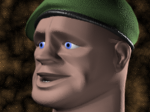
A, I
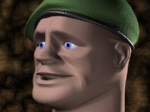
E
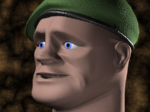
F,V
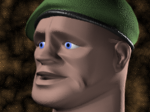
C, D, G, J, K, N, S, T, Y, Z
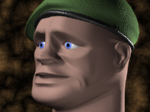
L,T

O
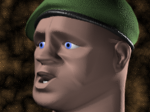
U
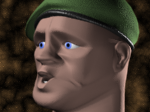
W,Q
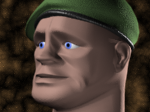
M,B,P (This target can be the same shape as the "at rest" base object)
Create as many expression targets as necessary for the character. Joy, sadness, surprise, evil can all have their own targets. Depending on the personality of the character, certain targets, like a terror target, may not be necessary. Targets like nostril flare, jaw-muscle bunching, temple twitching can be effective to give a character an edge. Each morph channel can contain a material as well: as you morph the brows up, a bump map can crease the forehead, for example.
Save time and create targets as the need arises; if the audio file or scene you are working on requires a look of surprise, create the "surprise" target while the mood of the scene is with you.
If the character has teeth, copy the teeth and the base head to create a new target. The teeth act as a guide to shape and position the lips.
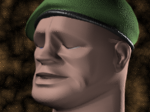
Blink
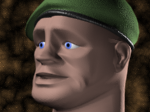
Brows up
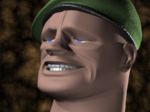
A blend of the Pain, Blink, and Brows targets
Example: To add the morpher modifier to an object and assign a morph target to a channel:
 Create panel, click
Create panel, click  (Geometry), if necessary.
(Geometry), if necessary.
 Modify panel, on the modifier stack display, right-click Quad Patch and choose Convert To: Editable Patch from the right-click
menu.
Modify panel, on the modifier stack display, right-click Quad Patch and choose Convert To: Editable Patch from the right-click
menu.
 Shift+Move to create a copy of the patch object.
Shift+Move to create a copy of the patch object.
 Modify panel
Modify panel  Selection rollout, click
Selection rollout, click  (Vertex).
(Vertex).
 move patch vertices to deform the patch surface.
move patch vertices to deform the patch surface.
 modifier stack, choose Editable Patch to go to the object (top) level. (The highlight should change from yellow to gray,
and the Vertex sub-object icon is no longer displayed at the right of the stack.)
modifier stack, choose Editable Patch to go to the object (top) level. (The highlight should change from yellow to gray,
and the Vertex sub-object icon is no longer displayed at the right of the stack.)
 Select the first patch object.
Select the first patch object.
 Modify panel, choose Morpher from the Modifier List.
Modify panel, choose Morpher from the Modifier List.
Whatever is assigned as the default float controller in 3ds Max will be assigned as the float controller on the morph channels as well. Float controllers handle the interpolation between keys; Bezier is the default float controller. You can assign the TCB float controller to the morph channels in Track View, if you prefer.
For morphing, the Bezier controller allows you to use function curves with vector handles on the keys for smoothing and easing control of interpolation in Track View. Default parameters of the TCB controller, however, handles morph interpolation with less overshoot. Try using both controllers, to decide which one you prefer.
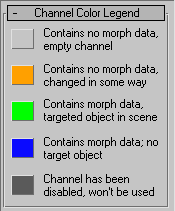
Turn on to limit morphing to vertices selected in a modifier below the Morpher modifier in the modifier stack.
If your are using Character Studio Physique, limit morph animation on the base object to just the head and exclude the neck, for example. Place the Physique modifier above the Morpher modifier and assign the head vertices as rigid (green) in the Physique modifier.
Click to assign the Morpher material to the base object (the object to which the Morpher modifier is applied).
To view and edit the assigned Morpher material, use the Material Editor . There is a direct correlation between the Channel Material Maps and the Channel list in the Morpher modifier (100 channels and 100 maps). For example, if channel 1 contains an eyebrows-up target and the Morpher material has a material assigned to map 1, then as the eyebrows are morphed, so is the material.
In the Morpher material, if a material is assigned to a map or channel that has no morph target in the Morpher modifier, you can use the channel spinner in the Morpher modifier to simply morph the material on a static object. See Morpher Material.
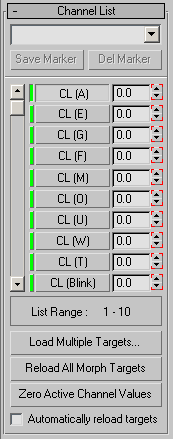
The upper section of the Channel List rollout contains controls for managing markers, which designate different locations in the list of morph targets. For example, channels 15 through 24 might contain all the emotion targets. Rather than scrolling to display these tracks, you can choose a marker from the list to display those channels.
Choose a previously saved marker in the list, or enter a new name in the text field and click Save Marker to create a new marker.
For example, channel 15 through 24 might contain all the emotion targets. Rather than scrolling to display these tracks, you can choose a marker from the list to display these channels in the list.
The Morpher modifier provides up to 100 morph channels. Scroll through the channels using the slider. Once you've assigned a morph target to a channel, the target's name appears in the channel list. Each channel has a percentage value field and a spinner to change the value.
You can change channel names and order in the Channel Parameters rollout.
Right-click a morph channel to display a right-click menu:

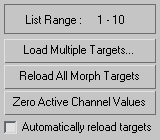
Click to create keys with a value of 0 for all active morph channels, if the Auto Key is on.
This is handy to prevent key interpolation from distorting the model. First click Zero Active Channel Values, and then set a particular channel to the value you want; only the altered channel affect the model.
The channel number button and channel name field at the top of this rollout reflect the current active channel in the channel list.

Click the number next to the channel name to display a menu. Use commands on the menu to group and organize channels, or to locate a channel.

Progressive morphing performs a tension-based interpolation, similar to the TCB animation controller, that creates smooth interpolation through each intermediary targets. This provides the artist with an unprecedented amount of control over the morph transformation.
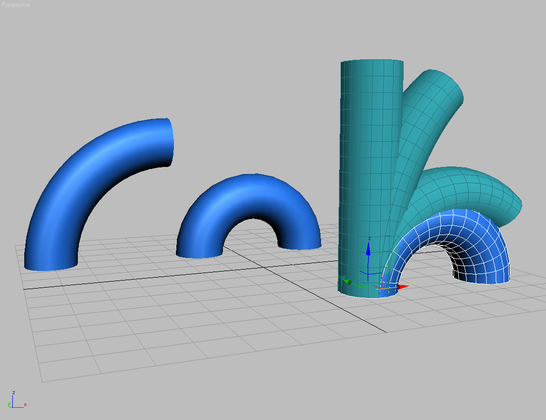
Morphed object using multiple, intermediary targets
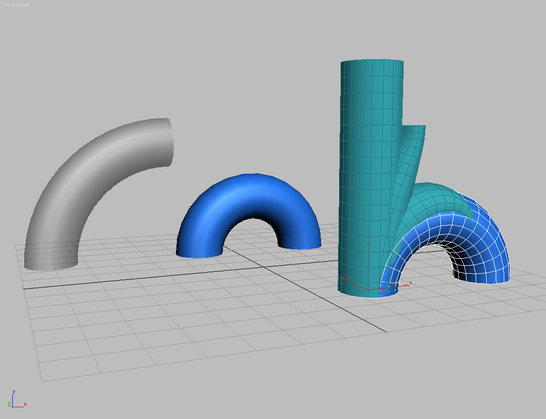
Morphed object using a single target
When morphing from one target to another, the object can sometimes pass through intermediary stages that are not desirable. For example, morphing a straight cylinder directly to a bent cylinder causes the cylinder to squash at intermediate stages.
You could get a better result by creating several intermediate morph targets for the object, and using them as channels. However, an easier solution is to create fewer intermediate targets, and use progressive morphing. With progressive morphing, you do not use the intermediate targets as channels; you use them to influence the end targets.